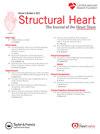经食管超声心动图与球囊取径术在经皮缝合患者卵圆孔未闭中的比较
IF 1.4
Q3 CARDIAC & CARDIOVASCULAR SYSTEMS
引用次数: 0
摘要
卵圆孔未闭(PFO)具有复杂的解剖结构,在关闭前评估其大小可能具有挑战性。我们的目的是探讨术前经食管超声心动图(TEE)与经皮PFO闭合患者PFO球囊大小的相关性。方法对100例因左循环矛盾血栓栓塞而行经皮PFO闭合术的患者进行回顾性单中心研究。使用线性回归分析将PFO施胶与TEE和球囊施胶所获得的措施进行比较。结果TEE测量的spfo尺寸小于球囊尺寸(2.19 mm [95% CI: 1.91 ~ 2.46] vs. 8.51 mm [95% CI: 8.02 ~ 9.00], p <;0.001)。此外,TEE测量的PFO通道长度和房间隔活动性均与球囊测量的PFO大小无关(斜率分别为- 0.018 [95% CI: - 0.117至0.081],R = 0.036, p = 0.719)和(斜率为0.049 [95% CI: - 0.043至0.141],R = 0.105, p = 0.297)。回归分析有统计学上的显著差异,但与球囊大小相比,TEE达到PFO和分流管大小之间的相关性较差。根据PFO分流管的大小对患者进行分流,中等大小的PFO与大、小PFO分别比较无统计学意义。然而,在小尺寸和大尺寸的PFO分流器之间观察到差异。结论TEE测量的spfo缺损与分流管大小与球囊大小相关性较差。PFO通道长度和间隔活动性都与球囊测量的PFO大小无关。本文章由计算机程序翻译,如有差异,请以英文原文为准。
Comparison of Patent Foramen Ovale Sizing by Transesophageal Echocardiography and Balloon Sizing in Patients Undergoing Percutaneous Closure
Background
A patent foramen ovale (PFO) has a complex anatomy, and evaluating the size before closure may be challenging. We aimed to investigate the correlation between preprocedural transesophageal echocardiography (TEE) and balloon sizing of PFO in patients undergoing percutaneous PFO closure.
Methods
A retrospective single-center study with analysis of 100 patients who, due to paradox thromboembolism in the left circulation, underwent percutaneous PFO closure. The PFO sizing was compared to measures attained by TEE and balloon sizing using linear regression analysis.
Results
PFO size measured by TEE occurred smaller than balloon sizing (2.19 mm [95% CI: 1.91 to 2.46] vs. 8.51 mm [95% CI: 8.02 to 9.00], p < 0.001). Additionally, neither the PFO channel length nor the atrial septal mobility measured by TEE correlated to the PFO size attained by balloon sizing, respectively (slope −0.018 [95% CI: −0.117 to 0.081], R = 0.036, p = 0.719) and (slope 0.049 [95% CI: ?0.043 to 0.141], R = 0.105, p = 0.297). Statistically significant difference in regression analysis but poor correlation was found between both TEE attained PFO and shunt size when compared to balloon sizing. Diverting patients according to the size of the PFO shunt was not statistically significant between PFO of moderate size compared, respectively, to a large and small PFO size. However, a difference was observed between a small and large PFO shunt size.
Conclusions
PFO defect and shunt size measured by TEE showed a poor correlation with balloon sizing. Neither PFO channel length nor septal mobility were correlated to the PFO size measured by balloon sizing.
求助全文
通过发布文献求助,成功后即可免费获取论文全文。
去求助
来源期刊

Structural Heart
Medicine-Cardiology and Cardiovascular Medicine
CiteScore
1.60
自引率
0.00%
发文量
81
 求助内容:
求助内容: 应助结果提醒方式:
应助结果提醒方式:


